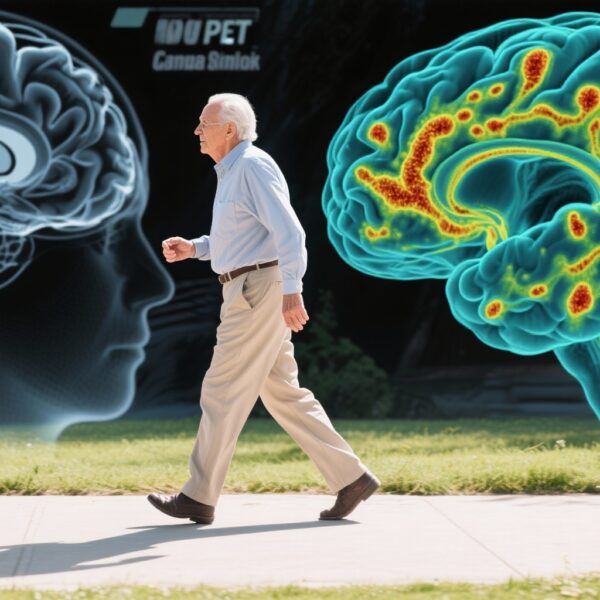Highlight
- Engagement in moderate-to-vigorous physical activity is associated with a slower increase in blood phosphorylated tau181 (p-tau181) levels, a biomarker linked to Alzheimer’s disease progression.
- The beneficial effects of moderate-to-vigorous physical activity on cognition are attenuated in older adults with elevated baseline p-tau181 concentrations.
- No baseline association was found between physical activity levels and p-tau181 concentrations, suggesting physical activity may influence tau pathology progression rather than baseline pathology.
- Higher thresholds of p-tau181 diminish cognitive benefits from physical activity, indicating neurodegenerative pathology may override activity-induced cognitive resilience.
Study Background
Physical activity is widely recognized as a modifiable lifestyle factor that can mitigate cognitive decline and reduce the risk of dementia. However, the mechanistic relationship between physical activity and Alzheimer’s disease (AD) pathophysiology, particularly relating to tau protein abnormalities, remains insufficiently understood. Tau proteins, especially phosphorylated tau181 (p-tau181), represent a pivotal biomarker reflecting neurofibrillary tangle pathology implicated in AD. As aging populations face increasing prevalence of cognitive disorders, clarifying how physical activity interacts with AD-related biomarkers could inform preventive strategies and therapeutic interventions for cognitive impairment. The Multidomain Alzheimer’s Preventive Trial (MAPT) offers valuable longitudinal data enabling secondary analyses to explore this relationship in older adults with memory complaints but without dementia.
Study Design
This investigation was a prespecified post-hoc secondary analysis using data from the MAPT, a multicenter, randomized, placebo-controlled superiority trial conducted at 13 memory centers across France and Monaco. The MAPT enrolled community-dwelling adults aged 70 years or older presenting with at least one risk factor: spontaneous memory complaints, slow gait speed (≤0.77 m/s), or impairment in instrumental activities of daily living, but without dementia diagnosis and with Mini Mental State Examination (MMSE) scores ≥24.
A total of 558 participants had p-tau181 blood concentrations measured at baseline or at 3 years or both, allowing examination of both cross-sectional and longitudinal relationships. Moderate-to-vigorous physical activity (MVPA) was self-reported and quantified in metabolic equivalent task (MET) minutes per week. Cognitive performance was assessed longitudinally through a composite Z-score averaging four validated cognitive tests, measured at baseline, 6 months, and annually up to 3 years.
Mixed-effect regression models characterized the associations between MVPA and p-tau181 concentrations over time, and assessed whether p-tau181 mediated or moderated the links between MVPA and cognition.
Key Findings
The analysis revealed that higher levels of MVPA were linked to significantly slower increases in p-tau181 concentrations over a 3-year period. Specifically, compared to inactive individuals, those with low or high MVPA demonstrated modest but statistically significant reductions in p-tau181 progression (low MVPA × time: B = -0.109, 95% CI -0.206 to -0.012, p=0.028; high MVPA × time: B = -0.114, 95% CI -0.208 to -0.020, p=0.018).
No significant cross-sectional association existed between baseline MVPA levels and p-tau181, indicating that MVPA may impact the trajectory of tau pathology rather than its baseline state.
Regarding cognition, higher MVPA correlated favorably with better cognitive composite scores cross-sectionally and longitudinally. However, these associations were attenuated with increasing baseline p-tau181 concentrations. Adjusted analyses suggested that when baseline p-tau181 exceeded 9.36 pg/mL for cross-sectional data and 3.5 pg/mL for longitudinal data, the beneficial cognitive effects of MVPA were no longer observed, indicating a threshold beyond which tau pathology limits physical activity’s neuroprotective potential.
Expert Commentary
This secondary analysis from the well-characterized MAPT cohort advances our understanding of how lifestyle factors modulate neurodegenerative processes in aging. The observation that MVPA slows p-tau181 elevation aligns with growing evidence suggesting exercise-related neuroprotection may mitigate tau-related neurodegeneration through mechanisms such as improved cerebral blood flow, neuroinflammation reduction, and enhanced proteostasis.
However, the attenuation of cognitive benefits in individuals with elevated p-tau181 underscores that advancing pathophysiology may counteract intervention effects. Such findings emphasize the importance of early lifestyle interventions before substantial tau accumulation occurs.
Limitations include reliance on self-reported physical activity, which introduces subjective bias, and the use of peripheral blood p-tau181 as a surrogate for central pathology, though recent studies support its validity. Additionally, generalizability is confined to older adults with memory complaints but no overt dementia. Future work integrating objective activity monitoring, larger sample sizes, and neuropathological validation could refine causal inferences.
Conclusion
This secondary analysis provides evidence that engaging in moderate-to-vigorous physical activity may attenuate the progression of tau-related pathology, indicated by slower increases in blood p-tau181, potentially slowing neurodegenerative mechanisms in aging. However, the protective cognitive effects of physical activity appear diminished in the presence of elevated baseline p-tau181 concentrations, highlighting a critical interplay between pathology burden and lifestyle benefits.
These findings underscore the need for promoting physical activity as a preventive strategy early in the cognitive continuum and encourage further large-scale studies to validate these observations. Tailoring interventions to biomarker profiles could optimize dementia prevention strategies.
Funding
This study was supported by Toulouse Gérontopôle, the French Ministry of Health, and the Pierre Fabre Research Institute.
References
Raffin J, Blennow K, Rolland Y, Cantet C, Guyonnet S, Vellas B, de Souto Barreto P; MAPT/IHU HealthAge Open Science Group. Associations between moderate-to-vigorous physical activity, p-tau181, and cognition in healthy older adults with memory complaints: a secondary analysis from the MAPT. Lancet Healthy Longev. 2025 Feb;6(2):100678. doi: 10.1016/j.lanhl.2024.100678. Epub 2025 Feb 24. PMID: 40015298.
Additional relevant literature:
1. Bennett DA, et al. “Physical Activity and Alzheimer’s Disease: Evidence from Epidemiologic Studies and Clinical Trials.” Curr Alzheimer Res. 2018; 15(7): 599-607.
2. Barthélemy NR, et al. “Blood Biomarkers for Tau Pathology in Alzheimer’s Disease and Other Tauopathies.” Nat Rev Neurol. 2020;16(3):150-160.
3. Erickson KI, et al. “Physical Activity, Brain Plasticity, and Alzheimer’s Disease.” Arch Med Res. 2017;48(8):745-753.



